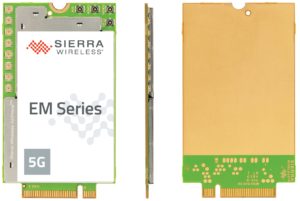The EM519x series of wireless modules from Sierra Wireless add 5G to embedded and IoT designs, with fallback to 4G and 3G.
5G networks coming online brings with it a need for more than phones. Over time, many devices will connect to 5G networks, with the first being routers and other networking equipment. While you can design 5G connectivity with chipsets, you can skip some of the engineering and design a module into your system. Sierra Wireless claims to be the first to make an embedded 5G module to the market. The EM919x 5G NR modules let you add 5G FR1 (sub-6 GHz) and FR2 (mmWave connectivity to your designs. The EM9190 supports both FR1 and FR2 (n257, n258, n260, and n261) while the EM9191 supports FR1 (n1, n2, n3, n5, n7, n8, n12, n20, n25, n28, n38, n40, n41, n48, n66, n71, n77, n78, n79) frequencies only.
Because of the short wavelengths of FR2 carriers, the modules include 4×4 beamforming antennas. For FR1, you supply your own antenna. Modules are factory calibrated for all supported frequency bands and functionally tested in RF chambers. “We must test the modules for FCC and carrier compliance,” said Sierra Wireless’ VP of 5G & Embedded Broadband Larry Zibrik in a conversation with 5GTW. The modules support networks from AT&T (FirstNet), docomo, LGU+, Telstra, and Verizon. the modules not only support 5G but can fall back to 4G LTE and even 3G, depending on available service. When operating at mmWave frequencies, the module supplies an IF frequency to the 5G chipset, which upconverts to the carrier frequency.
Incorporating 5G connectivity into devices other than phones is not for everyone, at least not yet. That’s our conclusion based on our conversation with Zibrik. “We work closely with customers on integration issues such as power, heat dissipation, and interference that can disrupt the module’s SIM card. The modules take care of 90% of the compliance issues. It’s up to final product’s engineers to handle the rest. That includes band masking, power supplies, thermal issues, and software issues.” To address thermal concerns, the module can operate at industrial temperatures, but you still need to address system-wide thermal issues.
The EM919x modules available with USB 3.1 or PCIe Gen 2 or 3 (single lane) interfaces. “We’ve seen customers integrate our LTE modules with Raspberry Pi microcontroller boards,” said Zibrik. Someday, engineers will add 5G to Raspberry Pi and other open-source processor boards, but that’s several years away.
Related articles



